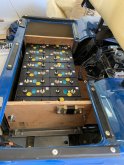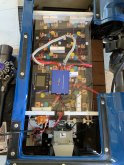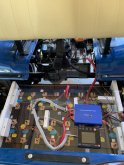The quick and dirty method.
For cell compression plates. Use 2 plastic cutting boards from your favorite megamart. Cut and drill for 4x 1/4" threaded rods, clamp together. Plywood works as well, typically 3/8 works great. I suggest washers under the nut heads.
Make a plywood box out of 1/2" quality plywood. Use right angle brackets and glue the joints. Another option is pocket screws (Kreg jig) and glue. Put the clamped pack in the box. Secure with wood blocks, or with a tight strap in 2 locations.
The typical plastic boxes are too thin for metal cases cells like that (in my opinion). At least for a mobile application. If you really want to use one, I suggest using firm closed cell foam to wedge the pack in the box. Another option is 1/4" plastic or plywood inserts floating in the box.
If you have a protected area already, you can mount the clamped pack into the cabinet/compartment directly. Ensure the pack is protected from moisture/spills/spray, leaks.
Pack leads can be insulated with liquid electrical tape and heat shrink tubing. If you think there is a any risk of the pack bouncing and hitting anything (conductive or not), then your pack IS NOT secured properly. There should be no relative motion between the pack and anything around it. Even if you insulate the leads really well (which is a good idea regardless), if the pack is moving in its enclosure, then vibration damage, loose fasteners, etc, will eventually be a problem.






